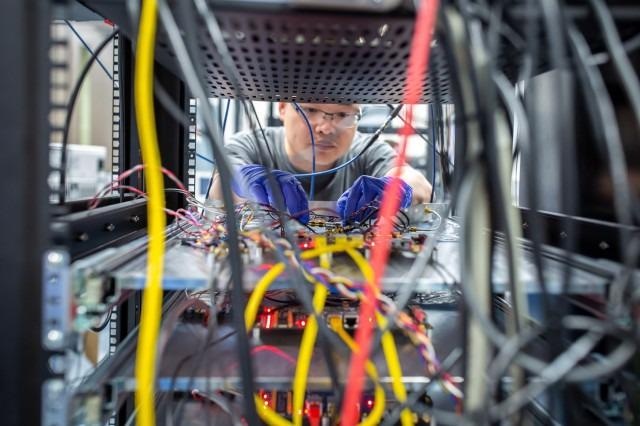Mar 12 2021
A new study funded by U.S. Army could lay the foundation for future quantum communication networks and large-scale quantum computers.
 Army-funded research sends entangled qubit states through a communication cable linking one quantum network node to a second node. This research could help lay new groundwork for future quantum communication networks and large-scale quantum computers. Image Credit: Nancy Wong, University of Chicago.
Army-funded research sends entangled qubit states through a communication cable linking one quantum network node to a second node. This research could help lay new groundwork for future quantum communication networks and large-scale quantum computers. Image Credit: Nancy Wong, University of Chicago.
Entangled qubit states were sent by researchers through a communication cable that connects one quantum network node to another one.
Researchers from the Pritzker School of Molecular Engineering at the University of Chicago also amplified an entangled state through the same cable initially by using the cable for entangling two qubits in each of two nodes and then by entangling these qubits with other qubits in the nodes.
The study was financially supported and managed by the U.S. Army Combat Capability Development, called DEVCOM, Army Research Laboratory’s Center for Distributed Quantum Information.
The study was published in the February 24th, 2021, issue of Nature, a peer-reviewed journal.
“The entanglement distribution results the team achieved brought together years of their research related to approaches for transferring quantum states and related to advanced fabrication procedures to realize the experiments,” stated Dr Sara Gamble, program manager at the Army Research Office, an element of the Army’s corporate research laboratory, and co-manager of the CDQI, which funded the work.
This is an exciting achievement and one that paves the way for increasingly complex experiments with additional quantum nodes that we’ll need for the large-scale quantum networks and computers of ultimate interest to the Army.
Dr Sara Gamble, Program Manager, Army Research Office
Quantum bits, qubits, constitute the fundamental units of quantum information.
Scientists and engineers have been leveraging their quantum properties, such as superposition, and their ability to be entangled together to develop next-generation quantum computers that can solve problems that could not be solved earlier.
The researchers used superconducting qubits, minuscule cryogenic circuits that can be controlled electrically.
Developing methods that allow us to transfer entangled states will be essential to scaling quantum computing.
Andrew Cleland, Study Lead and John A. MacLean Senior Professor of Molecular Engineering Innovation and Enterprise, University of Chicago
Entanglement is a correlation that can be formed between quantum entities like qubits. Entangling two qubits and making a measurement on one will impact the result of a measurement made on the other, even if the second one is physically distant from the first qubit.
The researchers developed an experimental set-up including three superconducting qubits in each of two nodes, to send the entangled states via the communication cable—a 1-m-long superconducting cable.
One qubit was connected in each node to the cable and then quantum states were sent, in the form of microwave photons, via the cable with very little information loss. The weak nature of quantum states renders this process very difficult.
The team created a system where the entire transfer process—node to cable to node—requires only a few tens of nanoseconds (where 1 nanosecond is one-billionth of 1 second). Thus, they could send entangled quantum states with minimal loss of information.
The system enabled them to increase the entanglement of qubits. The team used one qubit in each node and entangled them by typically sending a half-photon via the cable.
Then, this entanglement was extended to the other qubits in each node. Upon completion, all six qubits in the two nodes were entangled in a single universally entangled state.
“We want to show that superconducting qubits have a viable role going forward,” added Cleland.
A quantum communication network could possibly leverage this advance. The researchers intend to extend its system to three nodes to develop three-way entanglement.
The team was able to identify a primary limiting factor in this current experiment related to loss in some of the components. They have a clear path forward for increasingly complex experiments, which will enable us to explore new regimes in distributed entanglement.
Dr Fredrik Fatemi, Branch Chief for Quantum Sciences, DEVCOM ARL
Dr Fredrik Fatemi is also the co-manager of CDQI.
Breakthrough lays groundwork for future quantum networks
Video Credit: U.S. Army Research Laboratory
Journal Reference:
Zhong, Y., et al. (2021) Deterministic multi-qubit entanglement in a quantum network. Nature. doi.org/10.1038/s41586-021-03288-7.